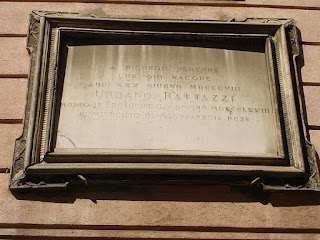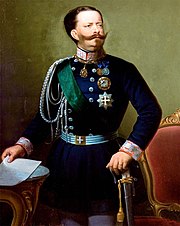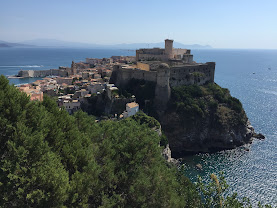Unpopular politician had anticlerical views
 |
| Urbano Rattazzi twice served as prime minister of the new Italy |
Rattazzi became prime minister in 1862, succeeding Bettino Ricasoli, and he held the office for nine months until his behaviour towards Garibaldi led to him being driven from office.
He served as prime minister again in 1867 from April to October, but was forced by King Victor Emmanuel II to resign again because of the Italian people’s reaction to his treatment of Garibaldi.
Rattazzi was married to the French novelist, Laetitia Marie Wyse Bonaparte, who was the great niece of the Emperor Napoleon I, and they had one daughter, Romana, who was born in 1871. He also had a nephew, Urbano Rattazzi Iuniore, who was appointed Minister of the Royal House during the reign of Umberto I.
As a young man, Urbano Rattazzi studied law in Turin and ran a successful legal practice in Turin and in Casale, in Piedmont.
From 1848, he represented Alessandria in the Sardinian Chamber of Deputies in Turin. He had allied himself to the Liberals, and using his debating powers, he contributed to the defeat of Cesare Balbo, who was then prime minister of Sardinia.
Under Sardinian Prime Minister Vincenzo Gioberti, Rattazzi became Minister of the Interior and his first act was to send a ministerial circular to all the bishops of the Kingdom, threatening them with arrest if they did not stop preaching against the new institutions.
 |
| Garibaldi, whose popularity with the people was not shared by Rattazzi |
With the Moderate Liberals, Rattazzi formed a coalition with the centre right, who were backed by Count Camillo Cavour, which brought about the fall of the cabinet led by Massimo d’Azeglio in 1852.
Rattazzi benefited from his alliance with Cavour and became Minister of Justice and Minister of the Interior. He suppressed monastic orders and restricted the influence of religious associations, demonstrating his anticlerical views. He had to resign in 1858 because of public opinion, but he later served in the cabinet of Alfonso Ferrero La Marmora before retiring in 1860.
After Italian unification in 1861, Rattazzi became president of the lower chamber in the first parliament of the newly unified kingdom. He then succeeded Ricasoli as prime minister, retaining for himself the portfolios of foreign affairs and the interior. He delivered the funeral eulogy for Cavour, after he died in 1861.
Rattazzi's government experience lasted a few months during which emerged the ‘Roman question’ - the conflict between the Papacy and the Italian government over the status of Rome and the Papal States following unification.
In the summer of 1862, Garibaldi tried to promote an expedition of volunteers to occupy Rome and put an end to the power of the Pope. Rattazzi, who was initially in favour of Garibaldi's action, changed his mind and called in the army.
In the resulting Battle of Aspromonte, the army dispersed the volunteers and arrested Garibaldi, who had been wounded during the clashes. Rattazzi was condemned by public opinion, which was on the side of Garibaldi and he was forced to resign. He was succeeded by Luigi Carlo Farini.
Rattazzi held the office of prime minister again for a few months in 1867. But then Garibaldi penetrated the Papal States with a contingent of volunteers and was later defeated by the Pope’s troops and a French expeditionary force. This led to the collapse of Rattazzi's majority, and Rattazzi was forced by King Victor Emmanuel II to resign. He was succeeded by Luigi Federico Menabrea.
Urbano Rattazzi died of liver cancer at his villa at Frosinone in Lazio in 1873. He was 64 years old. After ceremonies in Rome and Alessandria, Rattazzi's embalmed body was buried in the monumental cemetery in his home town.
 |
| The commemorative plaque that marks Urbano Rattazzi's place of birth in Alessandria |
Alessandria, where Rattazzi was born and is buried, is an historic city in Piedmont, situated about 90km (56 miles) to the southeast of Turin. There is a plaque above the entrance door to Rattazzi’s birthplace in the street now called Via Urbano Rattazzi, at number 43. After Napoleon won the Battle of Marengo in 1800, Alessandria became part of French territory and was made the capital of the area by the French. It became part of the Kingdom of Sardinia again in 1814 and later part of the Kingdom of Italy. One of its most important buildings is the Cittadella di Alessandria, a star fort and citadel built in the 18th century. Today it is one of the best preserved fortifications of that era and one of the few fortifications in Europe still in their original environment, with no buildings blocking the views of the ramparts, or a road that surrounds the ditches. Alessandria suffered extensive Allied bombing in World War Two but many areas have been rebuilt. The city is now a major Italian railway hub.
_-_Exterior.jpg) |
| The facade of the Cathedral of Santa Maria Assunta in Frosinone |
Frosinone, where Urbano Rattazzi died, is about 75 kilometres (47 miles) southeast of Rome in Lazio. It is the main city of the Valle Latina that extends from south of Rome to Cassino, the site of the Abbey of Monte Cassino and the famous battle in World War II. The city of Frosinone remained part of the Papal States and did not become part of the new Kingdom of Italy until as late as September 1870, three days before Italian troops were finally able to enter Rome at Porta Pia and install Victor Emanuel II in the Quirinale Palace. The Cathedral of Santa Maria Assunta, located at the highest point of the hill on which the historic centre of the city stands, is the most important church in Frosinone. With a marble facade, it has a 63m (207ft) bell tower which has been adopted as an emblem of the city.
Also on this day:
1916: The birth of actor Mario Carotenuto
1932: The laying of the first stone of the Fascist city of Latina
1961: The birth of novelist Gianrico Carofiglio
1986: The birth of Allegra Versace, niece of Gianni
.



































